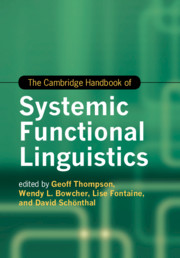Book contents
- The Cambridge Handbook of Systemic Functional Linguistics
- Cambridge Handbooks in Language and Linguistics
- The Cambridge Handbook of Systemic Functional Linguistics
- Copyright page
- Dedication
- Contents
- Figures
- Tables
- Contributors
- Preface
- Acknowledgements
- Introduction
- Part I SFL: The Model
- Part II Discourse Analysis within SFL
- Part III SFL in Application
- 19 Language Development
- 20 Applying SFL for Understanding and Fostering Instructed Second Language Development
- 21 Language and Education
- 22 Systemic Functional Linguistics and Computation
- 23 Clinical Linguistics
- 24 Language and Science, Language in Science, and Linguistics as Science
- 25 Language and Medicine
- 26 Language and Literature
- 27 Language and Social Media
- 28 Theorizing and Modelling Translation
- 29 Language Typology
- Index
- References
22 - Systemic Functional Linguistics and Computation
New Directions, New Challenges
from Part III - SFL in Application
Published online by Cambridge University Press: 03 May 2019
- The Cambridge Handbook of Systemic Functional Linguistics
- Cambridge Handbooks in Language and Linguistics
- The Cambridge Handbook of Systemic Functional Linguistics
- Copyright page
- Dedication
- Contents
- Figures
- Tables
- Contributors
- Preface
- Acknowledgements
- Introduction
- Part I SFL: The Model
- Part II Discourse Analysis within SFL
- Part III SFL in Application
- 19 Language Development
- 20 Applying SFL for Understanding and Fostering Instructed Second Language Development
- 21 Language and Education
- 22 Systemic Functional Linguistics and Computation
- 23 Clinical Linguistics
- 24 Language and Science, Language in Science, and Linguistics as Science
- 25 Language and Medicine
- 26 Language and Literature
- 27 Language and Social Media
- 28 Theorizing and Modelling Translation
- 29 Language Typology
- Index
- References
Summary
- Type
- Chapter
- Information
- The Cambridge Handbook of Systemic Functional Linguistics , pp. 561 - 586Publisher: Cambridge University PressPrint publication year: 2019
References
- 8
- Cited by

